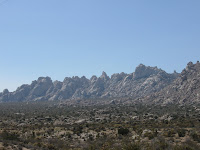
I awoke around 12:30 AM to what sounded like a dozen people doing the river dance in tap shoes about a foot above my head. The winds had picked up and with the gust of 40 plus MPH the whole tent was shaking. I glanced over at Jen and could tell from her look she was not to happy. My snoring has always made it hard for her to fall asleep. With the added slapping of the rain cover against the tent, sleeping seemed impossible for her. Both of us were wakened every 30 or so minutes through out the rest of the night. Finally, the sun came up and the winds slowly died off. When we had arrived at the Hole-in-the-wall camp site it was dusk. So upon exiting the tent we were greeted with a beautiful view of the surrounding mountains. The camp site gets it's name from the surrounding hills of rhyolite riddled with holes and small caves. After breakfast we checked out the Hole-in-the-wall information center and then headed out to get gas.


We headed down Essex Road toward I-40 to get gas in the small town of Fenner, Ca.. This gas station was located off I-40 on the historic Route 66. A couple of tall windmills and palm trees make it easily visible from the interstate. The gas station itself is quite unique, several drained fountains with interesting statues are located at the entrance. I can imagine this place was wonderful during the period Route 66 was the only highway around. Gas was a little expensive, being the only gas station around for miles.


After fueling up we got back on I-40 and headed west to the Kelbaker exit. This road would take us back into the Mojave Preserve. To the left rose the beautiful pale colored Granite Mountains covered in a light haze. As we rounded the bend and headed down into the valley, huge sand dunes became visible. The Kelso Dunes are nearly 700ft high and cover 45 square miles located in what is known as the Devil's Playground. These dunes were created by the prevailing winds and have been constantly changing for 25,000 years.
We stopped and checked out the Kelso Depot not to far up the road from the dunes. Located about 34 miles from Baker, Ca. off both the Kelso-Cima Road and the Kelbaker Road. Established in 1924, it served as a restaurant and train station on the Union Pacific railroad route from Salt Lake City, UT. to Los Angeles, Ca.. It now serves as visitor center and museum for the Mojave National Preserve. Inside, there are many informative exhibits describing the natural and cultural history of the preserve. There is an old telegraph station as well as a small gift shop and coffee house located in the depot.
Heading toward I-15 on the Kelso-Cima Road, we traveled into a large Joshua tree woodland. The remains of a couple old homes were located off to the side of the road. We stopped to let the dog's stretch their legs at Sunrise Rock while Jen and I took some photos. This area has the largest concentration of Joshua trees in the world. We stayed for awhile, taking in the huge white rock formations and the surrounding Joshua trees before heading back to Vegas.
























